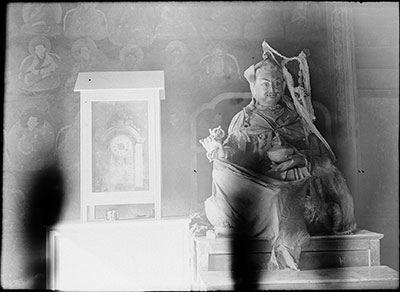
1998.131.321 (Film negative)


1998.131.321 (Film negative)

Frederick Spencer Chapman
Frederick Spencer Chapman
September 6th 1936
Lhasa > Potala > Clock
1998.131.321
85 x 116 mm
Negative film nitrate
Donated 1994
Faith Spencer Chapman
British Diplomatic Mission to Lhasa 1936-37
Frederick Spencer Chapman
C.14.6 [view film roll]
SC.T.2.321
In Negative - The number '6' has been scratched into the negative in the bottom right hand corner. This relates to the group of images referred to by Chapman as 'C.14' in his handlist of images taken whilst on the Mission to Lhasa in 1936-7. This small group of negatives (15 in all) were all used to take photographs of the interior of the Potala Palace [MS 11/4/2005]
Technical Information - This image was probably taken with a quarter plate Zeiss Nixe film or film pack camera as the negative is quarter-plate sized. See Chapman Lhasa The Holy City, [London: Chatto & Windus, 1938] for a description of the still and cine cameras that Chapman used as Mission photographer [MS 25/2/2005]
Manual Catalogues - Caption in Chapman's hand-written list of negatives made whilst on the Mission to Lhasa, 1936-7 [See PRM Manuscripts Collection]: 'Potala clock and a god (rather spoilt)' [MS 18/03/2006]
Other Information - Related Images: Images prefixed with 'C.14 comprise a group of negatives containing images of the 13th Dalai Lama’s tomb and views around the Potala. They were all taken on the Mission party's first official visit to the Potala on September 6th 1936 [MS 18/03/2006]
Other Information - Historical Background: Padmasambhava (also known as Guru Rinpoche) is believed to have come from Swat. Was invited to Tibet during the reign of Srong-tsen Gampo (8th c.) to diffuse the friction between the earlier Bon religion and Buddhism. Founded the first Tibetan Monastery at Samye. [Marina de Alarcón ZF 1995.1]
For Citation use:
The Tibet Album.
"Potala clock and images "
05 Dec. 2006. The Pitt Rivers Museum.
<http://tibet.prm.ox.ac.uk/photo_1998.131.321.html>.
For more information about photographic usage or to order prints, please visit the The Pitt Rivers Museum.
© The Pitt Rivers Museum